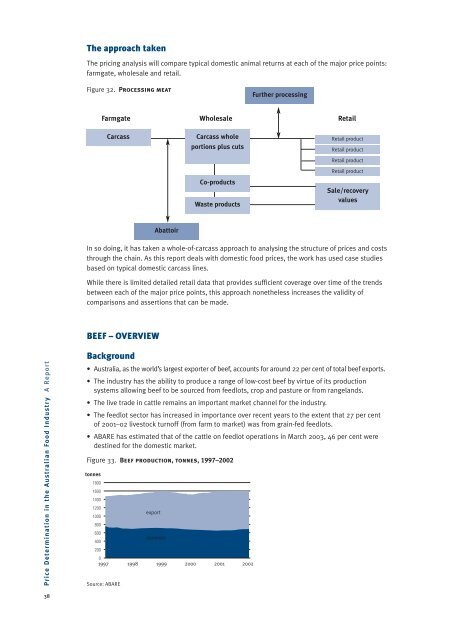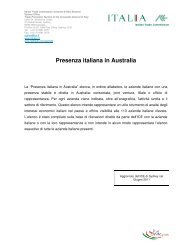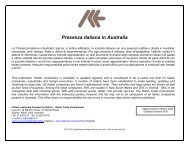Price Determination in the Australian Food Industry A Report
Price Determination in the Australian Food Industry A Report
Price Determination in the Australian Food Industry A Report
Create successful ePaper yourself
Turn your PDF publications into a flip-book with our unique Google optimized e-Paper software.
The approach taken<br />
The pric<strong>in</strong>g analysis will compare typical domestic animal returns at each of <strong>the</strong> major price po<strong>in</strong>ts:<br />
farmgate, wholesale and retail.<br />
Figure 32. Process<strong>in</strong>g meat<br />
Fur<strong>the</strong>r process<strong>in</strong>g<br />
Farmgate Wholesale Retail<br />
Carcass<br />
Carcass whole<br />
portions plus cuts<br />
Co-products<br />
Waste products<br />
Retail product<br />
Retail product<br />
Retail product<br />
Retail product<br />
Sale/recovery<br />
values<br />
Abattoir<br />
In so do<strong>in</strong>g, it has taken a whole-of-carcass approach to analys<strong>in</strong>g <strong>the</strong> structure of prices and costs<br />
through <strong>the</strong> cha<strong>in</strong>. As this report deals with domestic food prices, <strong>the</strong> work has used case studies<br />
based on typical domestic carcass l<strong>in</strong>es.<br />
While <strong>the</strong>re is limited detailed retail data that provides sufficient coverage over time of <strong>the</strong> trends<br />
between each of <strong>the</strong> major price po<strong>in</strong>ts, this approach none<strong>the</strong>less <strong>in</strong>creases <strong>the</strong> validity of<br />
comparisons and assertions that can be made.<br />
BEEF – OVERVIEW<br />
Background<br />
<strong>Price</strong> <strong>Determ<strong>in</strong>ation</strong> <strong>in</strong> <strong>the</strong> <strong>Australian</strong> <strong>Food</strong> <strong>Industry</strong> A <strong>Report</strong><br />
• Australia, as <strong>the</strong> world’s largest exporter of beef, accounts for around 22 per cent of total beef exports.<br />
• The <strong>in</strong>dustry has <strong>the</strong> ability to produce a range of low-cost beef by virtue of its production<br />
systems allow<strong>in</strong>g beef to be sourced from feedlots, crop and pasture or from rangelands.<br />
• The live trade <strong>in</strong> cattle rema<strong>in</strong>s an important market channel for <strong>the</strong> <strong>in</strong>dustry.<br />
• The feedlot sector has <strong>in</strong>creased <strong>in</strong> importance over recent years to <strong>the</strong> extent that 27 per cent<br />
of 2001–02 livestock turnoff (from farm to market) was from gra<strong>in</strong>-fed feedlots.<br />
• ABARE has estimated that of <strong>the</strong> cattle on feedlot operations <strong>in</strong> March 2003, 46 per cent were<br />
dest<strong>in</strong>ed for <strong>the</strong> domestic market.<br />
Figure 33. Beef production, tonnes, 1997–2002<br />
tonnes<br />
1800<br />
1600<br />
1400<br />
1200<br />
export<br />
1000<br />
800<br />
600<br />
domestic<br />
400<br />
200<br />
0<br />
1997 1998 1999 2000 2001 2002<br />
Source: ABARE<br />
38







